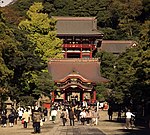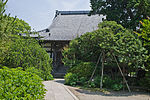Kenchō-ji

Kenchō-ji (建長寺) is a Rinzai Zen temple in Kamakura, Kanagawa Prefecture, Japan, which ranks first among Kamakura's so-called Five Great Zen Temples (the Kamakura Gozan) and is the oldest Zen training monastery in Japan. These temples were at the top of the Five Mountain System, a network of Zen temples started by the Hōjō Regents. Still very large, it originally had a full shichidō garan and 49 subtemples.The sangō is Kofukusan (巨福山). The temple was constructed on the orders of Emperor Go-Fukakusa and completed in 1253, fifth year of the Kenchō era, from which it takes its name. It was founded by Rankei Doryū, a Chinese Zen master who moved to Japan in 1246, spending some years in Kyushu and Kyoto before coming to Kamakura.
Excerpt from the Wikipedia article Kenchō-ji (License: CC BY-SA 3.0, Authors, Images).Kenchō-ji
Yokohama Kamakura line, Kamakura
Geographical coordinates (GPS) Address Nearby Places Show on map
Geographical coordinates (GPS)
| Latitude | Longitude |
|---|---|
| N 35.331788888889 ° | E 139.55534722222 ° |
Address
大庫裏
Yokohama Kamakura line
247-0062 Kamakura
Japan
Open on Google Maps











